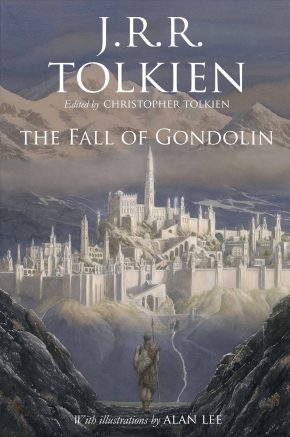
J.R.R. Tolkien is such a prolific author that, 45 years after his death, he is still providing us with publications that sell in their tens of thousands. With so many coming out in recent years – and the latest, The Fall of Gondolin, arriving in a couple of weeks – it is important to understand their significance to Tolkien’s legacy and not dismiss them as an attempt to make a quick buck.
Tolkien as a popular author
The Lord of the Rings ranks as one of the best-selling novels of all time, while first editions of The Hobbit have been rated among the most expensive of the 20th Century. With such a high demand and popularity for Tolkien’s works – and his influence recognised by the likes of George R.R. Martin, Stephen King, Neil Gaiman and Led Zeppelin – you can see why a publisher would be more than happy to see more books released.
But this isn’t simply about a publisher demanding more books; after all, The Hobbit, The Lord of the Rings and The Silmarillion don’t need help selling. As much as there is demand from readers, there is supply from the author. Tolkien was a brilliant author and sub-creator, beavering away at ideas and stories throughout his entire life, and bringing much of it together into the stories of Middle-earth. But whereas Tolkien was a master of creation, he was less proficient in finishing what he started: since Tolkien died, his son Christopher has shepherded (directly editing or authorising) a fairly impressive list of over 30 unique publications.
These books are not are not Christopher Tolkien just publishing his father’s old shopping lists, these are generously providing the world with the totality of the Professor’s creation. This is giving us an insight and understanding into his creative process, as well as enabling us to enjoy the (albeit often unfinished) creations and see the full magnitude, ingenuity and aesthetics of what Tolkien was endeavouring to achieve.
Over the last few years there has been a level of cynicism, and even fatigue, about these posthumous publications as 10 have been released in the last 11 years. There is a belief that the Tolkien Estate won’t be content until it has milked the cow dry in an attempt to sell any old scrap to readers. But – putting aside that they are hardly likely to need the money – this completely misses the point and fails to appreciate each publication in their own right.
Understanding Tolkien
Almost all recent Tolkien titles were not published for the general reader, but for scholars and devoted Tolkien readers. The Legend of Sigurd and Gudrún, The Fall of Arthur, Beowulf, The Story of Kullervo, A Secret Vice, and The Lay of Aotrou and Itroun are all academic by their very nature, especially since Tolkien’s own material is accompanied by essays from Christopher Tolkien, Verlyn Flieger or Dimitra Fimi and Andrew Higgins. These works provide careful, considered analysis of Tolkien and aren’t ordinarily meant for the general reader, so it is unfair to characterise these as trying to “milk it”.
However, some of the posthumous books were intended to have much wider appeal. The Silmarillion, Unfinished Tales, and The Children of Húrin were published for all those who had read The Hobbit and The Lord of the Rings and wanted more Middle-earth. The Fall of Gondolin fits in that category in following the template set down by Beren and Lúthien by sequencing Tolkien’s drafts together in one volume, providing the context and space to understand the development of the story.
Readers, fans and scholars of Tolkien will relish the excuse to have a chance to read The Fall of Gondolin again, one of the three “Great Tales” alongside The Children of Húrin and Beren and Lúthien; the story is one of beauty and, like much of Tolkien’s writings on the First Age, one of tragedy. And, academics and scholars who already recognise Tolkien as one of the most significant authors in English and modern literature, will be able to use this volume to get under the skin of Tolkien. This book does both, and therefore helps cement Tolkien’s legacy.
In The Tolkien Society we believe that the Tolkien’s ingenuity and creativity is a cornerstone of the entire modern fantasy genre, and the impact of his works places him up as one of the most significant in human history. The book sales, the adaptations, and the impact on other artists and causal readers is testament to that. If we had access to five draft versions of Hamlet the world would excitedly pour over them due to the significance of Shakespeare as an author; I have no doubt that future generations will praise Christopher Tolkien for allowing us access to these texts. So whenever someone says another Tolkien book is coming out, I say: “Bring it on!”